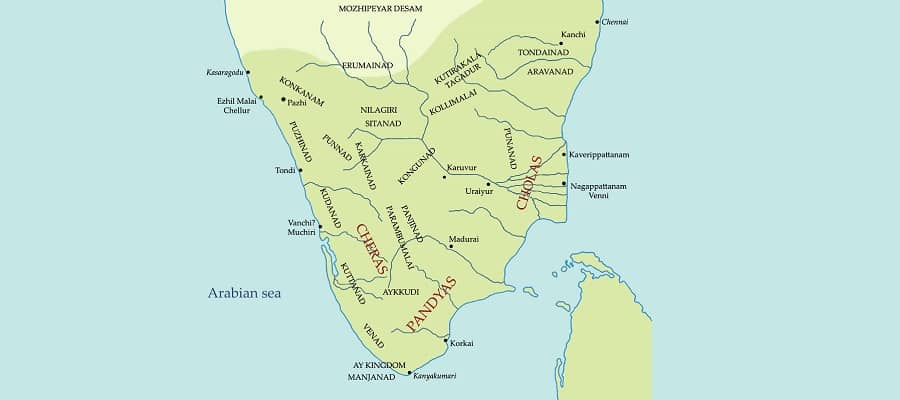Contents
sangam age literature society tamil period upsc
- The period between the 3rd century B.C. to the end of 3rd century A.D. in Southern India is known as Sangam Period.
- Their beginnings can be traced to 1000 B.C.
- But in many cases the megalithic phase lasted from about the 5th to the 1st century B.C.
- The Cholas, Pandyas and Keralaputras (Cheras) mentioned in the Asokan inscriptions were probably in the late megalithic phase of material culture.
- It has been named after the Sangam academies during that period.
- According to the Tamil legends, there were three Sangams (Academy of Tamil poets) held in the ancient South India popularly called Muchchangam.
- These Sangams flourished under the royal patronage of the Pandya kings of Madurai.
- 1st Sangam
- It is believed to be held at Madurai, attended by gods and legendary sages.
- No literary work of this Sangam is available.
- 2nd Sangam
- It was held at Kapadapuram, only Tolkappiyam survives from this.
- 3rd Sangam
- Held at Madurai was founded by Mudathirumaran.
- Their Chief god was Murugan
sangam age literature society tamil period upsc
>>>>>>
Cheras
- The Cheras ruled over major parts of modern Kerala.
- The capital of Cheras was Vanji.
- Tondi and Musiri were the important seaports in this period.
- The emblem of Cheras is the ‘bow and arrow’.
- The Pugalur inscription of the 1st century AD and Padirruppattu has reference to three generations of Chera rulers.
- Senguttuvan was the prominent ruler of this Chera dynasty.
- The military achievements of Senguttuvan have been recorded in epic Silapathikaram.
- He has done an expedition to the Himalayas where he defeated several North Indian rulers.
- Senguttuvan introduced the Pattini cult or the worship of Kannagi as the ideal wife in Tamil Nadu.
- He was the first to send an ambassador to China from South India.
>>>>>>>>
>>>>>>>>
Cholas
- The Chola kingdom in the Sangam period extended from present day Tiruchi district to Southern Andhra Pradesh.
- Initially, the capital of Chola was Uraiyur and later moved to Puhar (Tanjore)
- King Karikala was a prominent king of the Cholas dynasty.
- The insignia of Cholas was ‘tiger’.
- Pattinappalai written by Kadiyalur Uruttirangannanar depicts his life and military takeovers.
- Various Sangam poems indicate the Battle of Venni where he defeated the alliance of Pandyas, Cheras, and 11 minor chieftains.
- Vahaipparandalai was another important battle fought by Karikala.
- Trade and commerce prospered during his rule.
- He also built irrigation tanks near river Kaveri to make available water for reclaimed land from the forest for cultivation.
- Elara was another king, who conquest Sri lanka.
sangam age literature society tamil period upsc
>>>>>>>>
Pandyas
- Founded by a woman king
- The Pandyas ruled over the contemporary day Southern region of Tamil Nadu.
- Madurai was the capital of Pandyas.
- Their emblem was the ‘Carp’.
- King Nedunjeliyan also was known as Aryappadai Kadantha Neduncheliyan.
- According to mythology, the curse of the Kannagi, wife of Kovalan, burnt and destroyed Madurai.
- The socio-economic condition of the seaport of Korkai was mentioned in Maduraikkanji which was written by Mangudi Maruthanar.
- Famous for its pearls trade
>>>>>>>>
>>>>>>>>
Sangam Age Literature
- The Sangam literature includes Tolkappiyam, Ettutogai, Pattuppattu, Pathinenkilkanakku, and two epics named – Silappathigaram and Manimegalai .
- Tolkappiyam was authored by Tolkappiyar, it is considered the earliest of Tamil literary work.
- Though it is a work on Tamil grammar but it also provides insights on the political and socio-economic conditions of the time.
- Ettutogai (Eight Anthologies) consist of eight works
- The Pattuppattu (Ten Idylls) consist of ten works .
- Pathinenkilkanakku contains eighteen works about ethics and morals.
- The most important among these works is Tirukkural authored by Thiruvalluvar, the tamil great poet and philosopher.
- The two epics Silappathigaram is written by Elango Adigal and Manimegalai by Sittalai Sattanar.
- They also provide valuable details about the Sangam society and polity.
>>>>>>>>
>>>>>>>>
Other Sources
- The Greek authors like Megasthenes, Strabo, Pliny and Ptolemy mentioning commercial trade contacts between the West and South India.
- Also, the Ashokan inscriptions mention the Chera, Chola and Pandya rulers to the south of Mauryan empire.
- Another inscription, Hathikumbha inscription of Kharavela of Kalinga also has mention of Tamil kingdoms.
>>>>>>>>
>>>>>>>>
Position of Women during Sangam Age
- There were women poets like Avvaiyar, Nachchellaiyar, and Kakkaipadiniyar who flourished and contributed to Tamil literature.
- Love marriage was a common practice and women were allowed to choose their life partners.
- But, life of widows was miserable.
- There is also a mention the practice of Sati being prevalent in the higher strata of society.
>>>>>>>>
>>>>>>>>
Economy of the Sangam Age
- Agriculture was the chief occupation where rice was the most common crop.
- The handicraft included weaving, metal works and carpentry, ship building and making of ornaments using beads, stones and ivory.
- The port city of Puhar became an important place of foreign trade, as big ships entered this port containing precious goods.
- Other significant ports of commercial activity were Tondi, Musiri, Korkai, Arikkamedu and Marakkanam.
- Many gold and silver coins that were issued by the Roman Emperors like Augustus, Tiberius and Nero have been found in all parts of Tamil Nadu indicating flourishing trade.
- Major exports of the Sangam age was cotton fabrics and spices like pepper, ginger, cardamom, cinnamon and turmeric along with ivory products, pearls and precious stones.
- Major imports for the traders were horses, gold, and sweet wine.
>>>>>>>>





